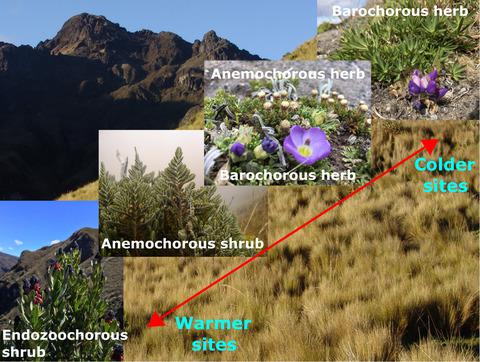Our official English website, www.x-mol.net, welcomes your
feedback! (Note: you will need to create a separate account there.)
Plant dispersal strategies of high tropical alpine communities across the Andes
Journal of Ecology ( IF 5.3 ) Pub Date : 2020-05-18 , DOI: 10.1111/1365-2745.13416 Carolina Tovar 1 , Inga Melcher 2, 3 , Buntarou Kusumoto 1, 4 , Francisco Cuesta 5 , Antoine Cleef 2 , Rosa Isela Meneses 6, 7 , Stephan Halloy 8 , Luis Daniel Llambí 9 , Stephan Beck 10 , Priscilla Muriel 11 , Ricardo Jaramillo 11 , Jorge Jácome 12 , Julieta Carilla 13
中文翻译:

安第斯山脉上热带高寒群落的植物扩散策略
更新日期:2020-05-18
Journal of Ecology ( IF 5.3 ) Pub Date : 2020-05-18 , DOI: 10.1111/1365-2745.13416 Carolina Tovar 1 , Inga Melcher 2, 3 , Buntarou Kusumoto 1, 4 , Francisco Cuesta 5 , Antoine Cleef 2 , Rosa Isela Meneses 6, 7 , Stephan Halloy 8 , Luis Daniel Llambí 9 , Stephan Beck 10 , Priscilla Muriel 11 , Ricardo Jaramillo 11 , Jorge Jácome 12 , Julieta Carilla 13
Affiliation

|
- Dispersal is a key ecological process that influences plant community assembly. Therefore, understanding whether dispersal strategies are associated with climate is of utmost importance, particularly in areas greatly exposed to climate change. We examined alpine plant communities located in the mountain summits of the tropical Andes across a 4,000‐km latitudinal gradient. We investigated species dispersal strategies and tested their association with climatic conditions and their evolutionary history.
- We used dispersal‐related traits (dispersal mode and growth form) to characterize dispersal strategies for 486 species recorded on 49 mountain summits. Then we analysed the phylogenetic signal of traits and investigated the association between dispersal traits, phylogeny, climate and space using structural equation modelling and fourth‐corner analysis together with RLQ ordination.
- A median of 36% species in the communities was anemochorous (wind‐dispersed) and herbaceous. This dispersal strategy was followed by the barochory‐herb combination (herbaceous with unspecialized seeds, dispersed by gravity) with a median of 26.3% species in the communities. The latter strategy was common among species with distributions restricted to alpine environments.
- While trait states were phylogenetically conserved, they were significantly associated with a temperature gradient. Low minimum air temperatures, found at higher latitudes/elevations, were correlated with the prevalence of barochory and the herb growth form, traits that are common among Caryophyllales, Brassicaceae and Poaceae. Milder temperatures, found at lower latitudes/elevations, were associated with endozoochorous, shrub species mostly from the Ericaceae family. Anemochorous species were found all along the temperature gradient, possibly due to the success of anemochorous Compositae species in alpine regions. We also found that trait state dominance was more associated with the climatic conditions of the summit than with community phylogenetic structure. Although the evolutionary history of the tropical Andean flora has also shaped dispersal strategies, our results suggest that the environment had a more predominant role.
- Synthesis. We showed that dispersal‐related traits are strongly associated with a gradient of minimum air temperatures in the Andes. Global warming may weaken this key filter at tropical alpine summits, potentially altering community dispersal strategies in this region and thus, plant community structure and composition.
中文翻译:

安第斯山脉上热带高寒群落的植物扩散策略
- 分散是影响植物群落组装的关键生态过程。因此,最重要的是了解扩散策略是否与气候相关,特别是在气候变化严重的地区。我们研究了热带安第斯山脉山顶上海拔4,000公里的高山植物群落。我们研究了物种扩散策略,并测试了它们与气候条件及其进化史的关系。
- 我们使用了与散布相关的特征(散布方式和生长形式)来表征49个山峰上记录的486种物种的散布策略。然后,我们分析了性状的系统发育信号,并使用结构方程模型和第四角分析以及RLQ排序研究了分散性状,系统发育,气候和空间之间的关联。
- 群落中平均有36%的物种是绒毛的(风散的)和草本的。这种散布策略之后是bar-草组合(草皮与非专业种子,通过重力分散),社区中的物种中位数为26.3%。后一种策略在物种分布中很普遍,分布仅限于高山环境。
- 虽然性状状态在系统发育上是保守的,但它们与温度梯度显着相关。在较高的纬度/海拔上发现的最低最低气温较低,与重竹和草本生长形式的流行有关,这些特征在石竹科,十字花科和禾本科中很常见。在较低纬度/海拔高度发现的较温和的温度与大多数来自埃里科家族的内生食虫灌木物种有关。在整个温度梯度上都发现了风化物种,这可能是由于高山地区的风化菊科物种的成功所致。我们还发现,特质状态的优势与峰会的气候条件更相关,而不是与群落系统发育结构相关。
- 综合。我们表明,与散布有关的特征与安第斯山脉最低气温的梯度密切相关。全球变暖可能会削弱热带高山峰顶的主要过滤器,从而有可能改变该地区的社区传播策略,从而改变植物群落的结构和组成。











































 京公网安备 11010802027423号
京公网安备 11010802027423号